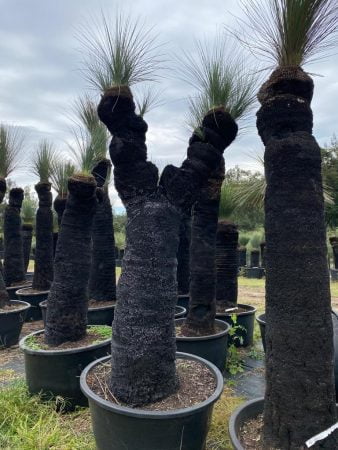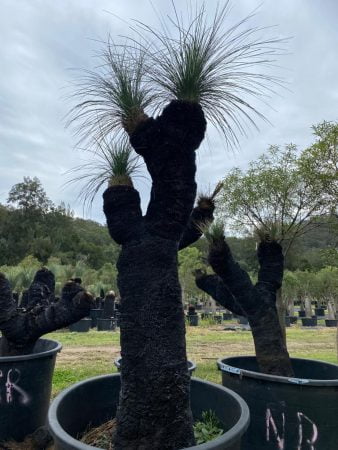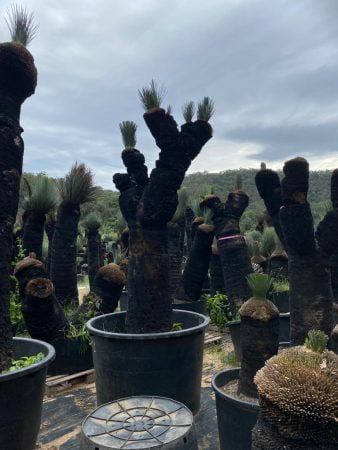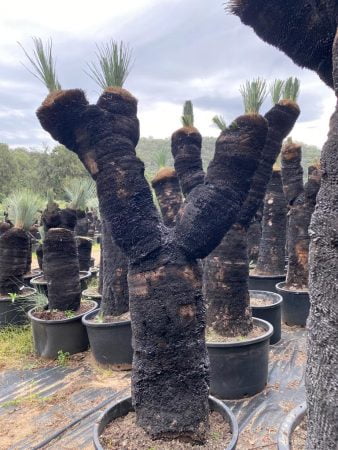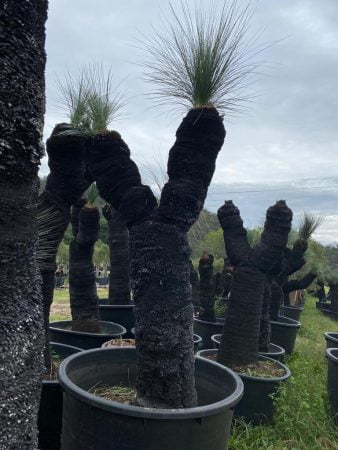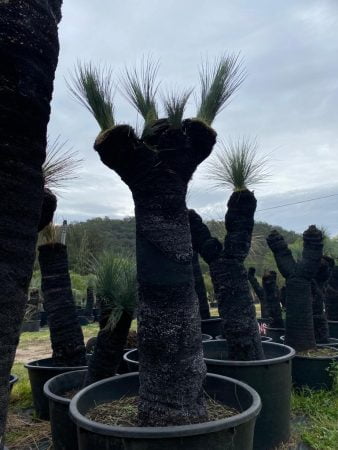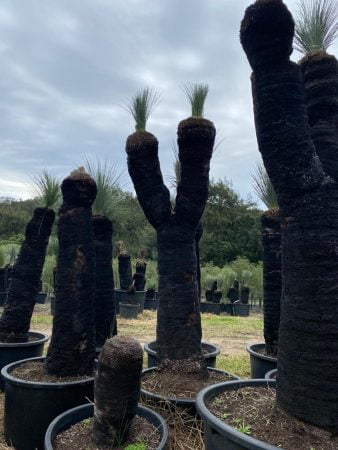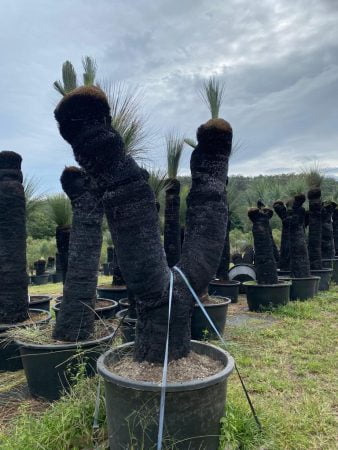Grass Tree
Grass Tree (Xanthorrhoea glauca)
| Scientific name: | Xanthorrhoea glauca |
|---|---|
| Common names: | Grass Tree, Glauca Grass Tree, Blue Grass Tree. |
| Trivia: | This plant does not have typical tree or grass structures and is in fact, a distant relative to lilies. Xanthorrhoea is a reference to the “yellow flow”, describing the resin produced by the leaves, and Glauca is derived from the Latin meaning of blue-green or grey to describe its’ glaucous leaves. |
| Synonyms: |
|
| Overview: | Native to New South Wales, the Glauca Grass Tree has a growth rate of only 1-2cm per year but it can grow to over 6 metres tall. The Xanthorrhoea Glauca variety is the only Grass Tree with the much sought after thick, blue-grey foliage which makes it a standout amongst all Grass Trees. |
| Ecology: |
The nectar rich flowers of the Glauca Grass Tree attract a wide range of insects, birds and mammals. It is especially fire-resistant and is often one of the first plants to regrow after a wildfire as the live growing tip is usually protected by the old, dead leaf base. |

About Grass Trees
The Grass Tree (Xanthorrhoea Glauca) is also known as the Glauca Grass Tree or Blue Grass Tree, which is one of 28 species belonging to the Xanthorrhoea genus of grass trees. The Grass Tree is an unusual plant iconic to Australia and is a contemporary inspiration to landscapers. It is also rooted in Aboriginal history and has a cultural and practical significance for Indigenous people. It was an important resource where the resin was extracted as an adhesive and sealant that became significant for trade. Spear shafts could also be made from the base and the flowers were the prime ingredient in making a light alcoholic beverage.
The Xanthorrhoea Glauca Grass Tree is the ultimate in Grass Trees. This unusual and iconic tree has a special place in the heart of many Australians and we believe that there is no finer native specimen that you could add to your landscape.
Native to New South Wales, the Grass Trees have a growth rate of only 1-2cm per year but they can grow to over 6 metres tall. We have examples of Grass Trees on our property that are over 600 years old!
The Xanthorrhoea Glauca variety is the only Grass Tree with the much sought-after thick, blue-grey foliage which makes it a standout amongst all Grass Trees.
We are fully licensed by the New South Wales Office of Environment & Heritage to sustainably harvest the Glauca Grass Tree from our property in Northern New South Wales.
Our Grass Trees grow in a micro-climate 1100 metres above sea level and when you walk around the property they make you feel as though you’re stepping back into prehistoric times. The temperature on our property varies from -5 to +45 degrees, but Glauca Grass Trees can survive all climates.
We have a wide range of Glauca Grass Trees available, from 20cm up to 2 metres tall. One of the unique features of our Glauca Grass Trees is the thickness of the stem. We have trees that are only 50cm tall but have a stem diameter of 40cm and some of our larger trees can be as wide as 60-70cm in diameter.
We specialise in multi-headed Grass Trees. Some have multiple stems coming straight from the ground; others have a single stem with multiple heads at the top. We have some truly amazing specimens.
The Glauca Grass Tree is the most hardy of all Grass Trees, it has an exceptionally high survival rate. This is unfortunately not a feature of other Grass Tree varieties – in particular the Xanthorrhoea Johnsonii Grass Tree. Because of this high survival rate, we are able to offer a 12-month survival guarantee with each of our Grass Trees.
Frequently Asked Questions
How much water do Grass Trees need?
For trees that are planted directly into the ground, keep them well watered for the first few months, then reduce the amount of watering as the plant becomes established. Pot-grown plants will always need regular watering. Always water from the base. Watering at the crown will cause it to rot.
Continue reading about Grass Tree care.
How do you propagate Grass Trees?
The Glauca Grass Tree can be propagated from seed.
Continue reading about Grass Tree propagation.
How much do Grass Trees grow?
Although the growth rate is small at only 1-2cm per year, glaucas are some of the tallest trees in its Genus. It can reach heights of over 6 metres and a width of around 3 metres.
Continue reading about Grass Tree growth.
How can Grass Trees be used?
The nectar-rich flower spike was soaked in water by Aboriginal people to make a sweet, slightly fermented drink. The live leaves and white leaf bases were eaten.
Continue reading about Grass Tree uses.
Where can I buy a Grass Tree?
We are one of the leading suppliers of Grass Trees in Australia. We are fully licensed by the NSW Office of Environment and Heritage to sustainably harvest several species and we are proud to say that we have one of the largest ranges of Grass Trees.
Click here to get a quote.
Grass Tree: Planting
As a long-living, slow-growing tree, when you plant a Glauca Grass Tree you are planting for future generations. It is therefore wise to give careful consideration to the choice of planting position. It makes an excellent feature tree as part of a rockery, or within a dry/water-wise garden scheme. It can be planted directly into the ground or in containers.
It prefers well-drained, aerated soil with low nutrient content and a sunny position. Full sun is best but it can tolerate light shade. It should ideally be planted in a sheltered spot where it is protected from strong or cold winds.
In its natural habitat, the Glauca Grass Tree is often found growing on the steep sides of gorges giving us a clue to its planting preferences – it does not like to have its roots set in water. Therefore, when planting in pots, add sand or gravel to the potting mix and raise the pot slightly off the ground so that the water can run freely away from the base.
If planted directly into the ground, this tree is best placed on top of a mound with sand or gravel incorporated into the soil around the planting area. These practices will help to aid drainage and prevent root rot.
It is also important to ensure that the top of the rootball is planted to the same depth in its new home as it was in its original pot; burying the trunk below soil level can encourage rotting.
For trees that are planted directly into the ground, keep them well watered for the first few months, then reduce the amount of watering gradually over time as the plant becomes established. Pot-grown plants will always need regular watering.
Whilst your new plant is establishing itself in its new home, it is a good idea to remove any flower spikes that appear. Flowering takes a lot of energy from the plant and it is more beneficial for the tree if this energy goes into root growth rather than flowering during the first year or two.
When transplanting the Grass Tree in your garden, it is important to note their roots are extremely sensitive and certain techniques should be applied when planting your new tree in the garden. Take care not to disturb the roots by cutting the plastic pot and gently pulling the plant out and placing it in the prepared hole, after which it should be watered regularly for the first month.
The Grass Tree will love a sunny to partial shade, elevated position whether planted in a pot or directly into the garden with added gravel for improved drainage. Once the plant is established, it will need daily watering for at least the first month. Thereafter, it requires minimal irrigation and will be drought and frost tolerant and will respond well to leave the trimming to stimulate root growth.
Grass Tree: Ongoing Care & Maintenance
Minimal ongoing care and maintenance are required as the Glauca Grass Tree is generally pest and disease-free and, being heat and drought-tolerant, it requires very little water. If watering is necessary, for example in a pot-grown specimen, always water from the base. Watering at the crown will cause it to rot.
The Glauca Grass Tree does not shed its old leaves. They accumulate to form a bushy skirt around the trunk, which makes an ideal habitat for native mammals and reptiles. It can take many years for the plant to start flowering, but when it does, a tall 4-metre spike extends above the leaves from which miniature white flowers will emerge between the Winter months of June to Spring in October. Interestingly, the plant’s starch reserves stored in the stem helps it quickly recover and re-sprout after exposure to wildfires, which in turn induces prolific flowering.
In the natural environment, the size of this ‘skirt’ is a good indicator of when the last wildfire occurred. The longer and thicker the skirt, the greater length of time since the last fire.
Grass Tree: Propagation
The Glauca Grass Tree can be propagated from seed.
The easiest way to grow a grass tree is to plant a seed. They are amazingly easy to grow from seed, especially in Australia. They can also be sprouted in a pot, however.
To gather seeds from an existing plant, watch for the birds to become interested in the seed stalk. Gather the stalk and place it in a paper bag. Let the stalk dry out, then gently shake the seeds from it.
Seed pods form from around October onwards. Collect them when they are ripe and ensure that they have fully dried out before removing the seeds.
Prepare a pot with a layer of coarse medium to ensure drainage, then fill it most of the way up with regular potting soil. Tuck your seed in the top ¼ inch of soil. Sprinkle a layer of sand over the soil to keep the seed from floating up when the pot is watered. This will help to keep the seed in contact with the potting mix. Keep moist but do not water excessively.
Wait patiently for the seed to sprout. It can take as long as six weeks for the first shoot to appear.
Alternatively, since the Glauca grass tree does not transplant well, if you live in an area where the tree can grow naturally out-of-doors, you can prepare a space in your garden or lawn area for the tree. Just dig a hole about 8 inches deep and at least six inches wide, add the drainage material if needed, and fill the hole with enriched soil or compost. Add the seed, and weight it with a little sand, if you wish.
In either case, keep the soil moist but not soaked, until the seedling appears. Once it is started, water moderately, allowing the plant to dry out between times.
This species flourishes in well-drained, low-nutrient soil making it an undemanding addition to any garden. It is a perennial, slow-growing plant achieving 0.8 to 6 cm of growth annually. However, its growth rate does increase if cultivated from seed, or when stimulated by season and rainfall. Typically, a fully matured plant will grow up to 6 metres in height.
When grown from seed, the Grass Tree seedlings start to develop roots that connect with fungi to obtain water and minerals. When the plant appears above the soil’s surface, it is protected by its tightly packed leaves. The leaf base is tough, but it does contain toxic chemicals that can result in anaesthetising effects when consumed.
Transplanting from the Wild
Currently, it is not legal to harvest a grass plant from the wild in Australia unless you have a license and a permit. Licensed individuals are sometimes allowed to collect grass plants from areas where the habitat is about to be destroyed. These might include places where the land is about to be developed for housing or industrial purposes, or where the environment has been damaged for other reasons.
Glauca grass trees do not transplant well. A serious consideration in addition to the legality is that most of the plants that are gathered from the wild simply do not live. One reason for this is that wild plants have a special type of mycorrhiza that have a symbiotic relationship with the grass tree’s roots. One way to help preserve a plant harvested from the wild is to get as much of the soil surrounding the roots as possible.
Another way to help a transplanted Glauca grass tree thrive is to prepare a mixture of brown sugar and water and use that to water the tree for about its first two years in its new location. The sugar water feeds the mycorrhiza and helps it and the tree to thrive.
Caution should be used when watering a Glauca grass tree. Over-watering is a common problem. Like many plants from deserts or semi-arid places, grass trees are highly susceptible to root rot and should always be planted in an area that is well-drained.
Grass Tree: Taxonomy and naming
Family: Asphodelaceae
Genus: Xanthorrhoea (From Greek ‘Xanthos’ meaning yellow and ‘Theo’ meaning to flow – a reference to the yellow resin that flows from the stem)
Species: Glauca (a reference to the blue-green glaucous leaves)
Synonyms: Xanthorrhoea glauca subsp. glauca,
Xanthorrhoea glauca subsp. angustifolia
Common names: Grass Tree, Grey Grass Tree, Black Boy, Yacca.
Grass Tree: History
The Xanthorrhoea Glauca Grass Tree is an unusual and iconic plant that has played a large part in aboriginal history, is seen in numerous colonial artworks and is a modern-day inspiration to landscape architects.
The common name of ‘Grass Tree’ was given because these trees are monocots that are able to form a trunk. The trunk is developed from the old leaf bases and its naturally occurring resin.
Grass Tree: Distribution and Habitat
The Xanthorrhoea Glauca Grass Tree is endemic to Australia. It is found growing wild along the southeast coast and extending inland through Victoria, New South Wales and South Eastern Queensland. It occurs in large numbers on rocky ranges and is occasionally seen in large communities among woodland, or on the steep sides of gorges. It is usually found growing in shallow basaltic soils but has also been found in serpentine soils, sandstone, deep coastal sands and hummocky grassland.
The Glauca Grass Tree’s natural distribution is around the rocky, steep ridges and deep coastal sands on Australia’s South East coast. They can also be found inland in shallow rich, igneous rock soils and hummock grasslands. Because the Glauca Tree is classified as part of Australia’s native flora, it is protected and can only be removed when complying with clearing laws.
Grass trees like a well-drained location and full sun. They are hardy plants, and resistant to moderate amounts of cold weather. They can be grown in Southern California, for example, where the weather can be quite chilly in December and January.
They are highly resistant to wildfire. In fact, a moderate brush fire can actually encourage the plants to bloom. As they grow, their lower fronds tend to droop down. In the wild, the condition of the lower branches can indicate the recency of brush fires.
Grass Tree: Appearance
The Xanthorrhoea Glauca Grass Tree is a beautiful, ancient, evergreen tree. It forms a wonderful trunk with single or branched stems and it is topped with shaggy, rounded heads that are made up of hundreds of long, sword-shaped glaucous leaves. They provide a wonderful element of texture to the garden and anyone with an appreciation of architectural plants cannot fail to be impressed.
Although the growth rate is small at only 1-2cm per year, it is one of the tallest trees in its Genus. It can reach heights of over 6 metres and a width of around 3 metres.
The black, burnt-looking trunk is made up of old leaf bases which become glued together by the resin contained within them. The trunk can be from 1-5 metres high and can be either single or multi-stemmed.
Leaves are strap-like and linear in shape. They measure approximately 3-4mm wide and 0.9-2.6mm thick. They are a blue-grey, glaucous colour and can grow to a length of around 1-2 metres.
Tall flower spikes appear on woody scapes (stalks) from June to October. The scape can measure around 0.5-1 metre long and 2-4.5cm in diameter. The flower spike itself grows to between 1-2 metres in length. Each flower spike contains numerous small white flowers with brown bracts.
The growth of a flower spike although spectacular consumes a huge amount of the tree’s energy. This means that flower spikes may not appear every year like clockwork so do not worry you have a season without flowers.
Grass Tree: Conservation
The Glauca Grass Tree is a protected species and harvesting from the wild is strictly regulated; it is therefore essential that you buy only from licensed and experienced growers. We are fully licensed by The New South Wales Office of Environment and Heritage to sustainably harvest the Glauca Grass Tree.
Grass Tree: Ecology
The nectar-rich flowers of the Glauca Grass Tree attract a wide range of insects, birds and mammals. It is especially fire-resistant and is often one of the first plants to regrow after a wildfire as the live-growing tip is usually protected by the old, dead leaf base.
Grass Tree: Uses
The Glauca Grass Tree was widely used by Aboriginal people.
The nectar-rich flower spike was soaked in water to make a sweet, slightly fermented drink. The live leaves and white leaf bases were eaten.
The flower spikes were dried and used as spear shafts for fishing and as fire sticks. The seed pods when dried made useful cutting implements.
The resin found at the base of the leaves is extremely useful as a glue which had many applications in weapon making. It was also used to patch up holes and cracks in water containers.
Request A Quote Now.
Call Us For An Instant Quote!
Australia:
0461 486 193
International:
+61 461 486 193
Email – hello@designertrees.com.au
